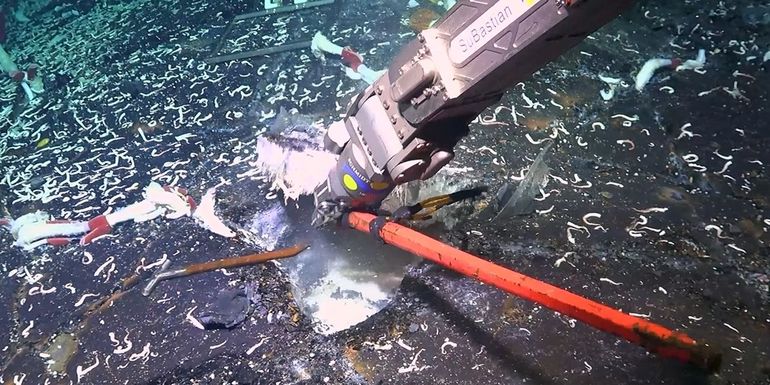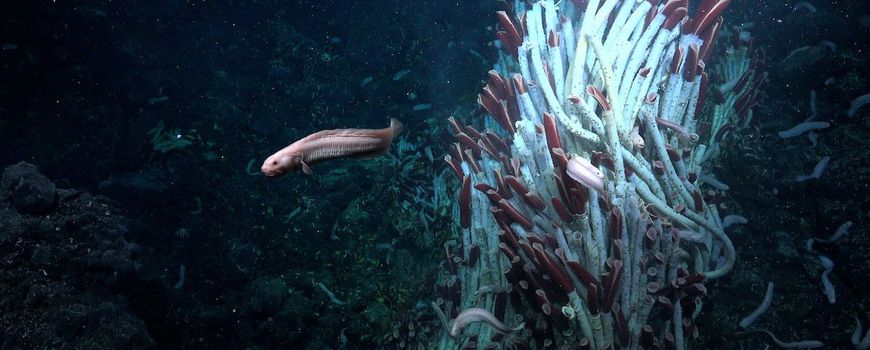New underground habitats
The discovery was made by an international team, including marine biologist Sabine Gollner of the Royal Netherlands Institute for Marine Research (NIOZ). “Scientists have studied hydrothermal vents for the past 46 years, but they have never looked for animals beneath these volcanic hot springs,” said Sabine Gollner. “We were thrilled to see underground cavities teeming with life. This discovery adds a new dimension to hydrothermal vents and shows that life exists all around them above and below the sea floor.”
“Our understanding of animal life in deep-sea hydrothermal vents has greatly expanded with this discovery,” said expedition leader Monica Bright. “There are two dynamic habitats. The animals above and below the ground thrive together in harmony, depending on the liquid from below and the oxygen in the seawater from above.”
A unique Dutch experience
The mission took scientists to the submarine volcano at an altitude of 2,500 meters in the eastern Pacific Ocean, west of Central America. To determine if the animals were moving through the warm springs, the science team used the Schmidt Ocean Institute’s ROV SuBastian underwater robot and new equipment developed by NIOZ. “We developed special lattice boxes in the Netherlands that were glued over cracks in the Earth’s crust,” says Sabine Gollner. “When we removed the boxes with the shell after several days, we discovered animals living below the surface in hydrothermal caves.”

Animals move through tunnels
In addition, the researchers found evidence that animals from the springs, such as tubeworms, can travel under the seafloor via the fluid from the springs to colonize new habitats. Tubeworms are one of the most common animals at hydrothermal vents, but very few young of these animals have been found in the waters above hydrothermal vents. This led scientists to suspect that they are moving underground to create new hydrothermal communities.
In hydrothermal vents, warm water floats up through cracks in the Earth’s crust that are caused by tectonic activity. If a new hydrothermal vent appears, the ecosystem will quickly follow. Animals colonize an area within a few years. Scientists don’t know how animal larvae find new hot springs. The international team is the first to investigate this matter. Researchers now confirm that tubeworm larvae can settle and even live beneath the sea floor. Finding a completely new ecosystem under the sea is proof of that.
Pictures of life under the sea and explanations from researchers (Source: Schmidt Ocean)
Explore our entire surroundings
“Discoveries made during each SOI Schmidt Ocean Institute (SOI) expedition underscore the urgent need to explore our entire ocean so we know what is out there in the deep sea,” said Wendy Schmidt, President and Co-Founder. “The discovery of new animals, landscapes, and now a whole new ecosystem shows how much more remains to be discovered about our oceans—and how important it is to protect what we don’t yet know or understand.”
“On Earth, we’ve known for a long time about animals that live in underground caves and in the ocean, animals that live in sand and mud. But for the first time, scientists have looked beneath hydrothermal vents,” SOI executive director Jyotika Virmani said. . “This truly remarkable discovery of a new ecosystem hidden beneath another ecosystem provides new evidence of life in fascinating places. The Schmidt Ocean Institute is proud to provide a platform for Dr. Bright and her team to gain new insights into these potentially vulnerable deep-sea mining systems.” “.
cooperation
Expedition on board a research vessel falcor (too) of the SOI led by Monika Brett of the University of Vienna. In collaboration with an international science team from the Netherlands, the United States, Germany, France, Costa Rica and Slovenia, she investigated a submarine volcano high in the eastern Pacific Ocean west of Central America.
Text and images: NIOZ (main image: vectors and tube worms)
Film: Schmidt Ocean Institute

Evil tv scholar. Proud twitter aficionado. Travel ninja. Hipster-friendly zombie fanatic.

